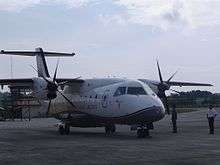Cebgo
 | |||||||
| |||||||
| Founded | 1995 (as SEAir Inc) | ||||||
|---|---|---|---|---|---|---|---|
| Hubs | |||||||
| Fleet size | 8 | ||||||
| Destinations | 14 | ||||||
| Company slogan | Why everyone flies | ||||||
| Parent company | Cebu Pacific | ||||||
| Headquarters | 3rd Floor Cebu Pacific Building, 8006 Domestic Road, Pasay City, Philippines 1301 | ||||||
| Website |
www | ||||||
Cebgo, Inc. is a low-cost airline serving the Philippines. It is the successor company to SEAir, Inc. and South East Asian Airlines, Inc. and then marketed as Tigerair Philippines. It is now owned by JG Summit, the parent company of Cebu Pacific which operates the airline. Its main base has been transferred from Clark International Airport (formerly Diosdado Macapagal International Airport), Angeles to Ninoy Aquino International Airport, Metro Manila.
History

The airline was established as SEAir Inc, in 1995 and started operations on the same year. However, its franchise was granted by Congress of the Philippines only on May 13, 2009 through Republic Act No. 9517.
The airline received its corporate registration from the Securities and Exchange Commission on 25 March 1995 mainly to operate aircraft leasing, chartering and few domestic scheduled flights. In May 1995, the airline was registered with the Clark Special Economic Zone to operate services in the Clark-Manila-Subic area and to tourist destinations throughout Luzon and the Visayas regions. It continued expanding its routes and opened a hub in Zamboanga City in 2002.
On 29 September 2006, a deal was announced in which Singapore-based Tigerair would enter a commercial and operational tie-up with SEAIR from February 2007.[1] The tie-up was finally approved in 2008 after protest from four other Philippine airlines. However, due to the unfavorable operating environment, the plan was put into hiatus. Tigerair and SEAir revisited the partnership plan in 2010 and it was officially launched on 16 December 2010. Seats on flights operated by SEAir using two aircraft leased from Tiger were sold and marketed by Tiger for SEAir. Shortly after SEAir and Tigerair launched the partnership, Philippine Airlines, Cebu Pacific, Zest Airways, and Air Philippines sent a letter of protest to the Department of Transportation and Communications claiming the partnership between SEAir and Tigerair was illegal and requested the authorities to stop flights operating under the partnership.[2] The Tigerair-SEAir Partnership began with international flights from Clark to Singapore, Hong Kong, and Macau. It was then expanded to domestic destination from Manila (NAIA) to Davao and Cebu (slated to launch in July 2011). However, the Civil Aeronautics Board (CAB) ordered the sales of the domestic flight under the partnership to be suspended on 20 May 2011, after receiving complaints from Philippine Airlines and Cebu Pacific. Since the ban from CAB was lifted in October 2011, the planned domestic flight (between Manila(NAIA) to Davao and Cebu) was scheduled to start in May 2012.[3]
In February 2011, Tiger Airways Holdings Ltd, parent of Tigerair, purchased 32.5% shares of SEAir Inc. They increased the shares to 40% in August 2012.
In December 2012, CAB approved SEAir's application to form SEAir International, a full-service airline focusing on domestic and international leisure destinations, and an independent operation from Seair Inc. which was rebranded as "Tigerair Philippines": "The two carriers have some common shareholders but it is not a unit of the other. Seair-I was formed to take on the turboprop division [of Seair Inc.] which was excluded in the share sale with Tigerair."[4] SEAir Inc was renamed "Tigerair Philippines" on 7 June 2013.
In January 2014, Cebu Pacific Air announced that it was acquiring the entirety of Tigerair Philippines for US$14.5 million by buying all shares.[5]
In May 2015, for the fourth time, Tigerair Philippines rebranded into Cebgo to reflect the relationship between Tigerair Philippines as a wholly owned subsidiary airline of its parent Cebu Pacific Air.[6]
By October 2015, Cebgo returned 5 Airbus A320 to Cebu Pacific and thereafter operated a pure Turboprop fleet of ATR 72 - 500.
Destinations
Cebgo domestic destinations includes Manila, Cebu, Busuanga, Davao, Laoag, Iloilo, Naga, Kalibo, Cagayan de Oro, Bacolod, Tacloban, Caticlan, Butuan, Tandag, Camiguin, Dipolog, Dumaguete, Legazpi, Ozamiz, Pagadian, Siargao and Surigao .
Fleet

As of March 2016, Cebgo's fleet includes the following aircraft:[7]
| Aircraft | Total | Orders | Passengers | Notes |
|---|---|---|---|---|
| ATR 72-500 | 8 | — | 72 | All painted in Cebu Pacific livery |
| ATR 72-600 | 2 | 16 | 78 | Deliveries from Q3 2016, launch customer of the new high density Armonia cabin[8] |
| Total | 10 | 16 |
| Aircraft | Total | Notes |
|---|---|---|
| Dornier 328-110 | 3 | Retired in 2012 |
| Let L-410UVP-E Turbolet | 2 | |
| Airbus A320-200 | 5 | All aircraft painted in Cebu Pacific livery |
| Boeing 737-700 (Cargo) | 2 | |
References
- ↑ "Channel NewsAsia". Channel NewsAsia.
- ↑ Airlines hit SEAir, Tiger Airways partnership
- ↑ "BusinessWorld - Seair readies new routes with ban lifted". bworldonline.com.
- ↑ "Seair International cleared for takeoff". InterAksyon.com.
- ↑ Dennis, William (January 8, 2014). "Cebu Pacific To Acquire Tigerair Philippines". Aviation International News. Retrieved 9 January 2014.
- ↑ Manila Bulletin. "Tigerair Philippines renamed Cebgo". mb.com.ph.
- ↑ "SEAIR - South East Asian Airlines Fleet Details and History". planespotters.net.
- ↑ "Cebu Pacific Air orders 16 ATR 72-600s at the Paris Air Show" (Press release). Cebu Pacific. Retrieved June 16, 2015.
External links
| Wikimedia Commons has media related to South East Asian Airlines. |